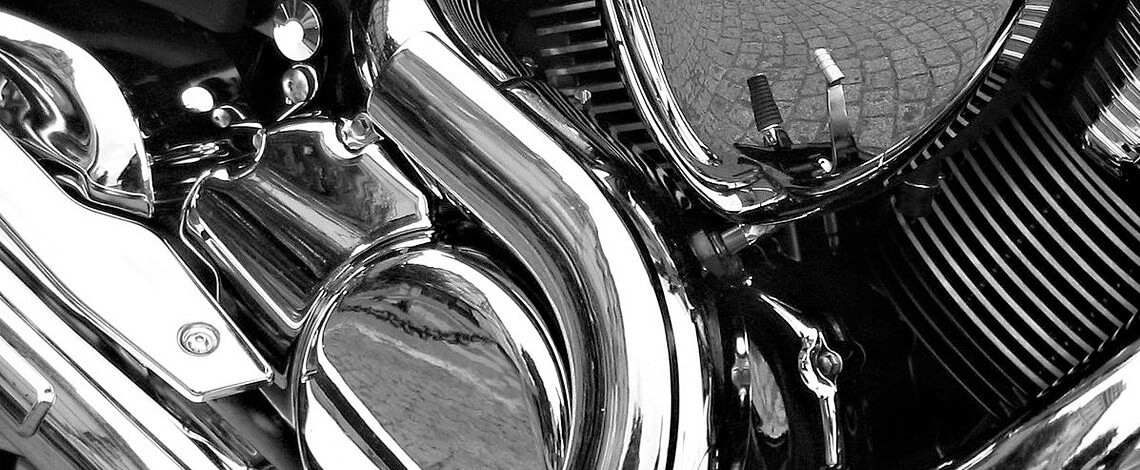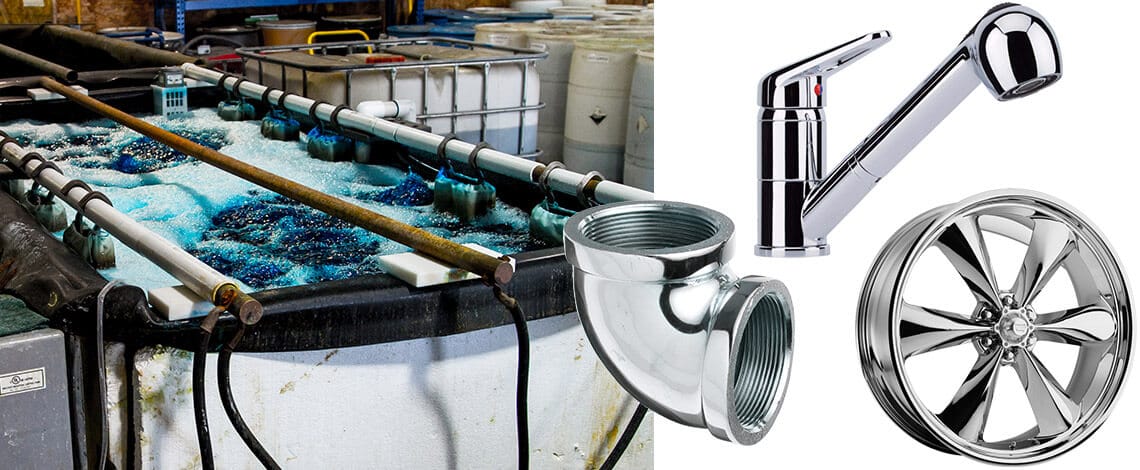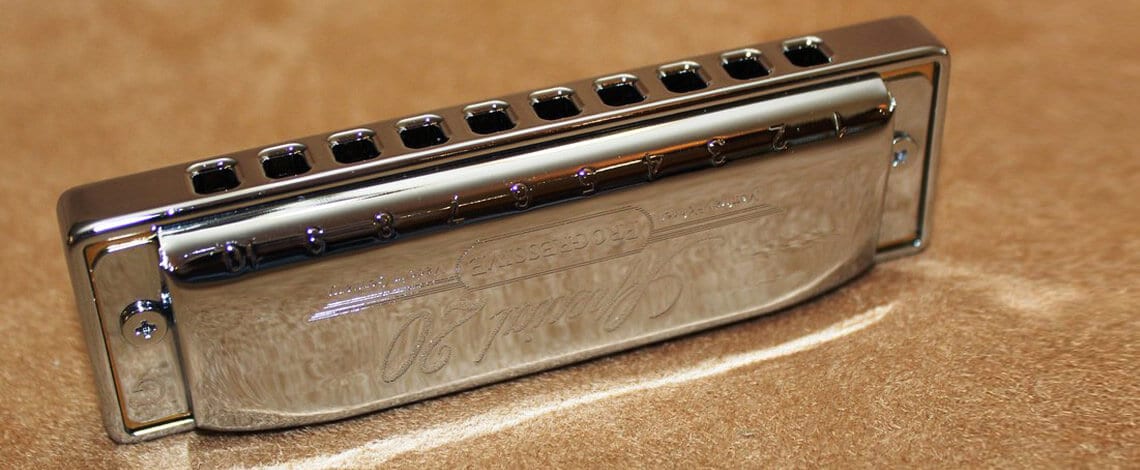Decorative chromium electroplating is the fundamental method of transferring the chemical and physical attributes of chromium onto the outer layer of another metal that is cheap as well as easily formable. These materials include plastics and steel whose surfaces can be easily reformed by decorative chromium electrodepositing.

The note-worthy attributes of chromium as a metal used for electrodepositing are the decorative and protective properties it posses. Chromium, when deposited, can resist tarnishing, scratches, wear and tear as well as corrosion.
Another vital reason for high retentivity of chromium in electroplating is its high lubricating nature. The deposits are the most desirable in the market due to all these characteristics.
Chromium decorative electrodeposition is done mainly on nickel electroplates which are deposited on substrates like steel, copper alloys, plastics, die zinc casts and aluminum. Nickel is mostly used in place of others because of its ability to guard the substrate against corrosion, add to the attractive decorative bluish-white outlook of chromium as well as the fact that it is resistant to oxidation on the surface by chromium.
Chromium plating can only be done directly on stainless steel while a nickel passes through the pre-plating process before chromium plating. Many or a layer of copper or nickel may come before the deposits of chromium owing to the reason behind the plating. The outlook of the deposits of chromium can be changed with dull, satin, bright or mechanical deposits of reformed nickel before the electroplating with chromium. This decorative deposit of chromium is made in 0.000002 to 0.00002 inch in range. When deposits are thicker, it is known as functional chromium which looks duller with seen cracks.
The initial deposit of chromium is from electrodepositing electrolyte which contains ions of chromium that is hexavalent. This was replaced by a chromium ion with a vacancy of three which is less harmful than the hexavalent decorative chromium in 1975. This was less toxic and can form metallic snow like deposit which nearly resembles that of hexavalent chromium of bluish white deposits, pewter that is deep-looking, nearly decorative lack deposits or a deposit that looks like stainless steel.
All electrodepositing activities with chrome either with a hexavalent or trivalent look so much alike though one of them may have the edge over the other in some cases like, the cost of the solution of hexavalent chromium which is less than trivalent should make it be preferred. However when you think of how fluoride content of it etches the substrates like steel and copper, causing metallic pollution of the electro-depositing bath thereby multiplying the rejects and operating defaults.
Chromium trivalent plating which does not contain fluoride melts iron and copper through its contamination is metallic and is easily removable from the electrolyte of trivalent chromium. Hence, through this electrodepositing with trivalent chromium over white alloys of copper, free nickel, chrome-like decorative parts, and nickel are formed. A solution of hexavalent chromium will lead to a great problem.
Hexavalent Chromium Electrodepositing
The electrolyte of chromium hexavalent needs a means of getting chromium and other elements that quickens the plating process for its electrodepositing activities.
During the advent of the initial technique which was named Sargeant, conventional or nanocatalyst process, sulfate or hexavalent chromium solutions were the only catalysts. Introduction of Fluoride to the former conventional operation of hexavalent chromium depositing bath quicken the operations or the properties of the deposits named it a dual or a mixed-catalyst bath. Other additives with organic properties can be used as quickening catalysts too.
This type of process as described above is only necessary when the peculiar characteristics of the content in mixed catalyst method are required. The high cost and difficulties associated with this process bring high rejects for it than in the traditional method.
The advantages arising from the mixed-catalyst process are still numerous such as, not reactive to interruptions to electric current, great speed, better coating, ability to be deposited on surfaces that are passive, bright ranges that are wider, the high level of tolerance to impurities.
The fundamental hexavalent chromium processes are the same in the sense that there is chromic trioxide that produces chromic acid as well as sulfate ion in water. This is joined by sulfate salt or sulfuric acid.
The mechanism of Hexavalent Chromium Electrodepositing
Sulfate as the catalyst is introduced to fluoride or organic catalyst which together with current density and bath chemistry, determines how efficient the reaction can be in depositing. This will always trigger off a negative reaction in which excess power is consumed. Oxidation of as well as the creation of trivalent chromium takes place, and Lead oxide film appears on the anode.
This conventional dilute solution is made up of 250 g/l of chromic acid as well as 2.5 g/l sulfate while its concentrated bath consists of chromic trioxide of about400 g/l to 4.0 g/l sulfate.
The dilute moderately activates the substrate of nickel, gives better coating and a current efficiency that is consistent, cheap quick in electroplating and forms little wastes only. While, concentration A Form of it is the best in the coating, resist impurities better, needs low voltage for operation but is more expensive due to high concentration. Of chromium and high level of wastages in coat treatment. In all, close control of the ratio of the weight of the reactants is required to form plating results because they are more consistent.
In these two methods a moderate ratio is to be preferred since too low causes poor coating, and a limiting density and high one slows down the rate of deposition, dull throwing, higher coating power as well as reducing the density of the current.
The introduction of the fluoride catalyst hastens adjustment in weight ratio, while the chromium concentration of the two bath is similar, but the use of a secondary quicker makes the concentration of sulfate to reduce.
It is good however to conduct a control experiment on these processes to check their accuracies.
Trivalent Chromium Plating
This is a safer and efficient technique. It was introduced in the middle of 1970 as a preferable method to hexavalent technique. The plating method wiped out many of the problems created by the former method which has been listed above and gave chromium plating a better outlook.
Though much was not written about this method due to the difference in the chemistries behind their formation, it has gained wider acceptance in the electroplating industries due to its attributes. The trivalent process is more reactive to metallic impurities that make the deposits black and changes the coating strength as well as the plating power than hexavalent. The regenerable resin is used to wipe off all the metallic impurities in the solution. Other fast or slow processes can still be used to eliminate the problems.
Equipment used
Nickel tanks, trivalent tanks as well as equipment are designed to look alike. Their tank linings ought to be formed from synthetic materials like PVC, polypropylene, and plastisol. You can use the same design for air agitation. Graphite which is insoluble is used as the anode and replaced if there is mechanical destruction. Insoluble anodes are used for sulfate process with a catalytic covering that is recoatable.

Heating and cooling in the trivalent processes are done by using titanium or Teflon coils. Relining or replacing of the tank when diverting from hexavalent to trivalent chromium process as well as eliminating ventilation equipment that is no longer useful is vital. This is because a little residue of lead can lead to electroplating defects. The use of hexavalent operational chromium rectifier is necessary. The current of the electrodepositing rack should suit the amperage they are to carry, and there should be efficiency as well as utilization of the advantages that should come from the plating bath and minimization of the demerits. The electrodepositing amperage for trivalent plating is 1½ of that used in a hexavalent method to design the rack for a weaker current.
You can use hexavalent chromium racks in the trivalent process, but you cannot do the same with racks designed using trivalent chromium process. This is because the trivalent process does not burn but has more covering as well as throwing ability than the hexavalent method. The rack from hexavalent chromium technique is meant just to conquer the deficiencies that are associated with chromium electroplating process. Productivity is thereby raised, shielding as well as robbing of some part that is more affected by current density is stopped. Hexavalent chromium technique can sometimes require the use of auxiliary anodes for obtaining cover in most of the recess; it is rather not so in the trivalent process which on the other hand does not need scrubbers and, and does not go for tank ventilation if the room has enough ventilation during the process. Trivalent chromium practices are similar to that used in nickel too especially in most regions of the world. This is so because; by the way, it wipes out odor and mist. Trivalent chromium technique possesses a mist suppressor that is Non-PFOS. The concentration of chromium is lowered, and oxidation, as well as toxicity properties, are reduced in the method than in hexavalent chromium plating. Trivalent chromium in its solution state can drain and rinse with ease, thereby, lowering the quantity of drag out of chromium.
If there are dried solutions on the way, it is not harmful because of the trivalent state of chromium. No stain occurs, unrecoverable solutions are treated as a waste though it decreases drag out, leaves contaminates in the solution for electrodepositing. All these attributes are contradictory to hexavalent chromium. Because the trivalent process does not burn, have more throwing ability and better coating than hexavalent, the parts can be kept closely on racks, and more current density surfaces will face the anodes. The racks can be decorated for maximum nickel electroplating. And these hexavalent chromium racks are formed to overcome the shortcomings of the chromium process.
Waste treatment method
The following ways are used to treat waste encountered in this process.
- Reduce the quantity of the drag out the solution from the electroplating tank.
- Replace as much as possible of the materials dragged out back to the tank.
- All electrodepositing solution that cannot be recovered is to be treated as wastes. Though it leads to waste reduction in the electroplating solution, few drag-out retains contaminants within the confinement of the electrodepositing solution, thus disorganizing the prerequisites of the maintaining a highly pure electrodepositing solution which will enable it to meet up with the needed deposit properties.
Owing to the poor draining ability of the hexavalent chromium process as well as misting, much of the solution is compulsorily removed from its decorative plating tank. Methods used for replacement of the drag-outs to the tank during hexavalent chromium plating to minimize the cost of waste treatment and that of chemicals are ion exchange and vacuum evaporators.
Since it is hard to wipe out metallic impurities from electrodepositing solutions of the hexavalent chromium process, it is, therefore, advisable to send any solution with excess metallic contamination out to be recovered.
Metallic contaminants have a greater effect on trivalent chromium than it does to hexavalent chromium but the mysteries behind the chromium trivalent method makes elimination of these impurities easier and thereby making the desire to forgo the solution because of metallic impurities less.
It is still good to use atmospheric evaporators to lower the volume of the solution so that all trivalent chromium which can be gotten is put back into the plating tank. Another method of removing metallic contaminants in chromium trivalent process is either dummying which is a rather a slow process or by a chemical precipitation method which is a faster technique. The most efficient and effective method is by the use of a direct resin treatment on the electrodepositing solution to eradicate all metallic impurities that are common, and this helps to stop the building up of more metallic impurities and wipe out any alteration in color of the deposit as well as the characteristic behavior of metallic contaminates. The cost for waste treating of a trivalent chromium electroplating solution of the same volume, if ever such case of treatment may arise, is just one-tenth of hexavalent treatment cost.
From a technical perspective, chromium hexavalent techniques are mostly irritable to organic contaminations because the hexavalent chromium ion kills most organics to form trivalent chromium ions. Being a pollutant, excess trivalent chromium should be reversed back to the state of hexavalent chromium. The most known way of doing this is dummying at a cathode density of 600 A/ft2, an anode current density of 12 A/ft2. Trivalent chromium techniques are irritable to organic contaminates but on some occasions, organics must be eradicated. In most of the cases, carbon filtering is ok while steady carbon treatment or peroxide treatment is necessary for others.
Corrosion Protection
Chromium decorative deposits play a vital role in the protection of the base metal from nickel or chromium process. They provide appealing color, wear, corrosion resistance, as well as tarnish resistance.

Though hexavalent chromium deposits and decorative trivalent deposits are used interchangeably, there are still some vital differences. Hence, it is worthy to note that hexavalent process ions give only short-term protection against corrosion on non- chromium layers through chromatin the part. Trivalent ions need post-electroplating for equivalent protection to be achieved. Micro discontinuous chromium electrodepositing is needed in cases that require corrosion resistance.
Using a controlled system of microscopic cracks or pores, the corrosion speed between the base nickel deposits and the chromium distributed across the more than a thousand corrosion sites. This will lessen anodic current on nickel at one of the sites or the other thereby lowering the general corrosion rates. The advantage of this method is the creation of an attractive, active site which is spaced uniformly throughout the surface. If this is not done, there will be excess concentration on a little part which may lead to unsightly non-regularly gaped corrosion sites.
Deposits from hexavalent chromium process should pass through treatments to provide micro-discontinuity. Electrodepositing chromium over non-reactive particles which are co-plated in the nickel deposits is a unique method of getting microporous chromium. While light sprays on the hard, brittle chromium droplets with 60 to 80 hard mesh particles makes for microporous chromium at points of contacts. Trivalent chromium droplets of less than 20 millionths are micro-discontinuous while those over 25 millionths are said to be micro-cracked. In some cases of deposits using the trivalent method, particle nickel is not vital in obtaining the needed quantity of active sites.
But if micro-discontinuity is not effected, hexavalent will simply micro-crack in use if it is plated over 0.000002 millionth in thickness. Due to its brittle and hard nature, crack-free or hexavalent chromium process deposits will macro-crack while in use. So some areas have stopped using micro-cracked deposits since they don’t retain their reflective nature faster than like micro-porous deposits.
Black Decorative Chromium Electroplating
Light black chromium droplets are used for the following:
- Functional applications as in anti-glare layers, collectors of radiations from the sun for production of heat.
- Decorative applications, like, plumbing fixtures, furniture, optical equipment, and automotive as well as hard wares builders.
This inspires users’ love for the product. Hence, its demand is based on how its black nature lures the customers. The black hexavalent deposits low wear and tear resistance and a higher degree of microporosity enhance absorption of waxes, paints as well as oil. During the process of other post-treatments, this characteristic is needed for improving corrosion resistance better outlook and wearability.
Black trivalent chromium droplets have the same properties with standard chromium droplets. Post-chromium treatment is vital when more corrosion protection is needed.
The trivalent process is still preferable to designers for exterior as well as interior automotive for all processes involving black chromium, and the thickness of almost 0.25 microns is compulsory.
Chromium Bulk Plating
This is a method used for electroplating of bulky items that cannot be plated by racking method. Hence, they are placed in trays or barrels and plated in bulk. This reduces cost yet many rejects of this method is due to inability to plate completely.
Chromium does not do proper coating, and there is gray coating due to poor contact with the cathode. Hexavalent if properly controlled can get good coverage with a high complexed solution containing fluoride. The nickel used should be less passive.
